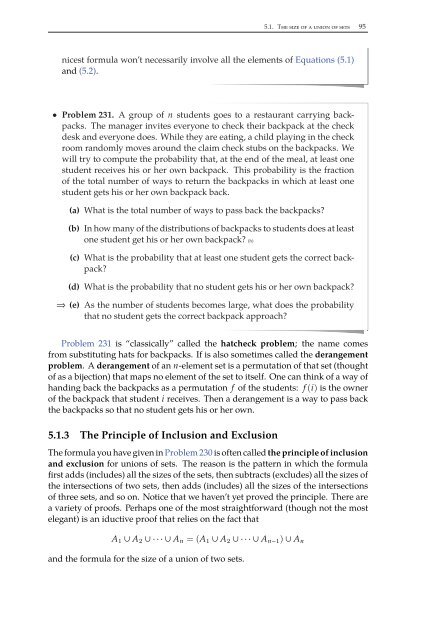Combinatorics Through Guided Discovery, 2004a
Combinatorics Through Guided Discovery, 2004a
Combinatorics Through Guided Discovery, 2004a
Create successful ePaper yourself
Turn your PDF publications into a flip-book with our unique Google optimized e-Paper software.
5.1. The size of a union of sets 95<br />
nicest formula won’t necessarily involve all the elements of Equations (5.1)<br />
and (5.2).<br />
• Problem 231. A group of n students goes to a restaurant carrying backpacks.<br />
The manager invites everyone to check their backpack at the check<br />
desk and everyone does. While they are eating, a child playing in the check<br />
room randomly moves around the claim check stubs on the backpacks. We<br />
will try to compute the probability that, at the end of the meal, at least one<br />
student receives his or her own backpack. This probability is the fraction<br />
of the total number of ways to return the backpacks in which at least one<br />
student gets his or her own backpack back.<br />
(a) What is the total number of ways to pass back the backpacks?<br />
(b) In how many of the distributions of backpacks to students does at least<br />
one student get his or her own backpack? (h)<br />
(c) What is the probability that at least one student gets the correct backpack?<br />
(d) What is the probability that no student gets his or her own backpack?<br />
⇒<br />
(e)<br />
As the number of students becomes large, what does the probability<br />
that no student gets the correct backpack approach?<br />
Problem 231 is “classically” called the hatcheck problem; the name comes<br />
from substituting hats for backpacks. If is also sometimes called the derangement<br />
problem. Aderangement of an n-element set is a permutation of that set (thought<br />
of as a bijection) that maps no element of the set to itself. One can think of a way of<br />
handing back the backpacks as a permutation f of the students: f (i) is the owner<br />
of the backpack that student i receives. Then a derangement is a way to pass back<br />
the backpacks so that no student gets his or her own.<br />
5.1.3 The Principle of Inclusion and Exclusion<br />
The formula you have given in Problem 230 is often called the principle of inclusion<br />
and exclusion for unions of sets. The reason is the pattern in which the formula<br />
first adds (includes) all the sizes of the sets, then subtracts (excludes) all the sizes of<br />
the intersections of two sets, then adds (includes) all the sizes of the intersections<br />
of three sets, and so on. Notice that we haven’t yet proved the principle. There are<br />
a variety of proofs. Perhaps one of the most straightforward (though not the most<br />
elegant) is an iductive proof that relies on the fact that<br />
A 1 ∪ A 2 ∪···∪A n = (A 1 ∪ A 2 ∪···∪A n−1 ) ∪ A n<br />
and the formula for the size of a union of two sets.


















